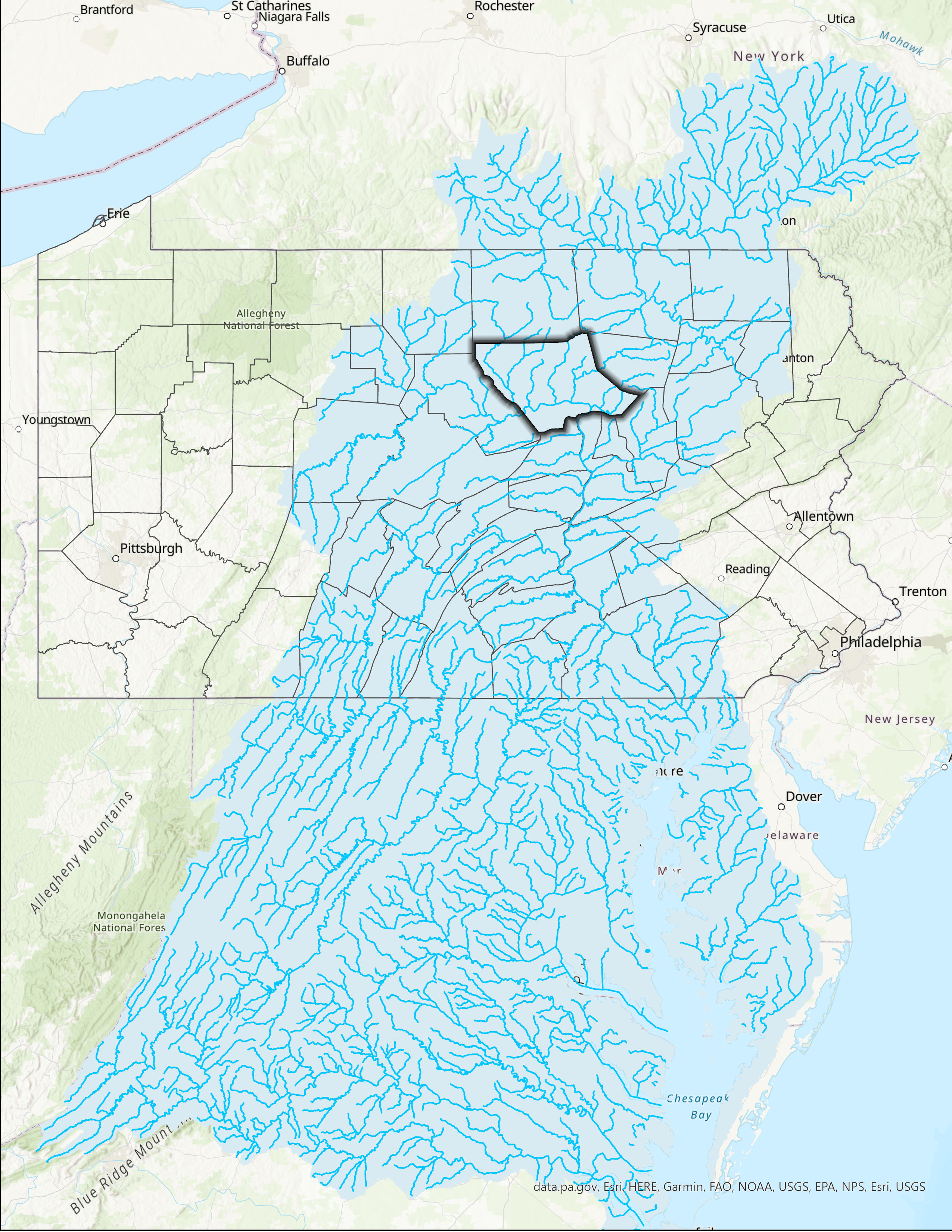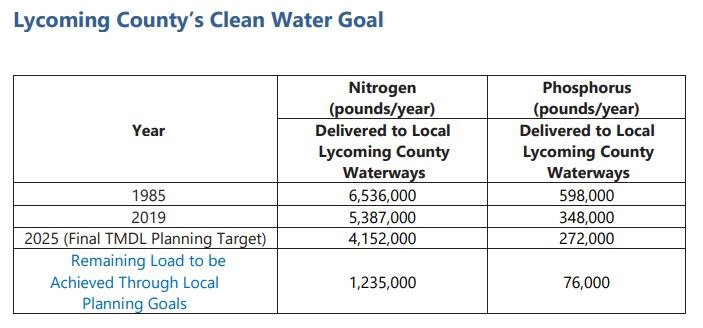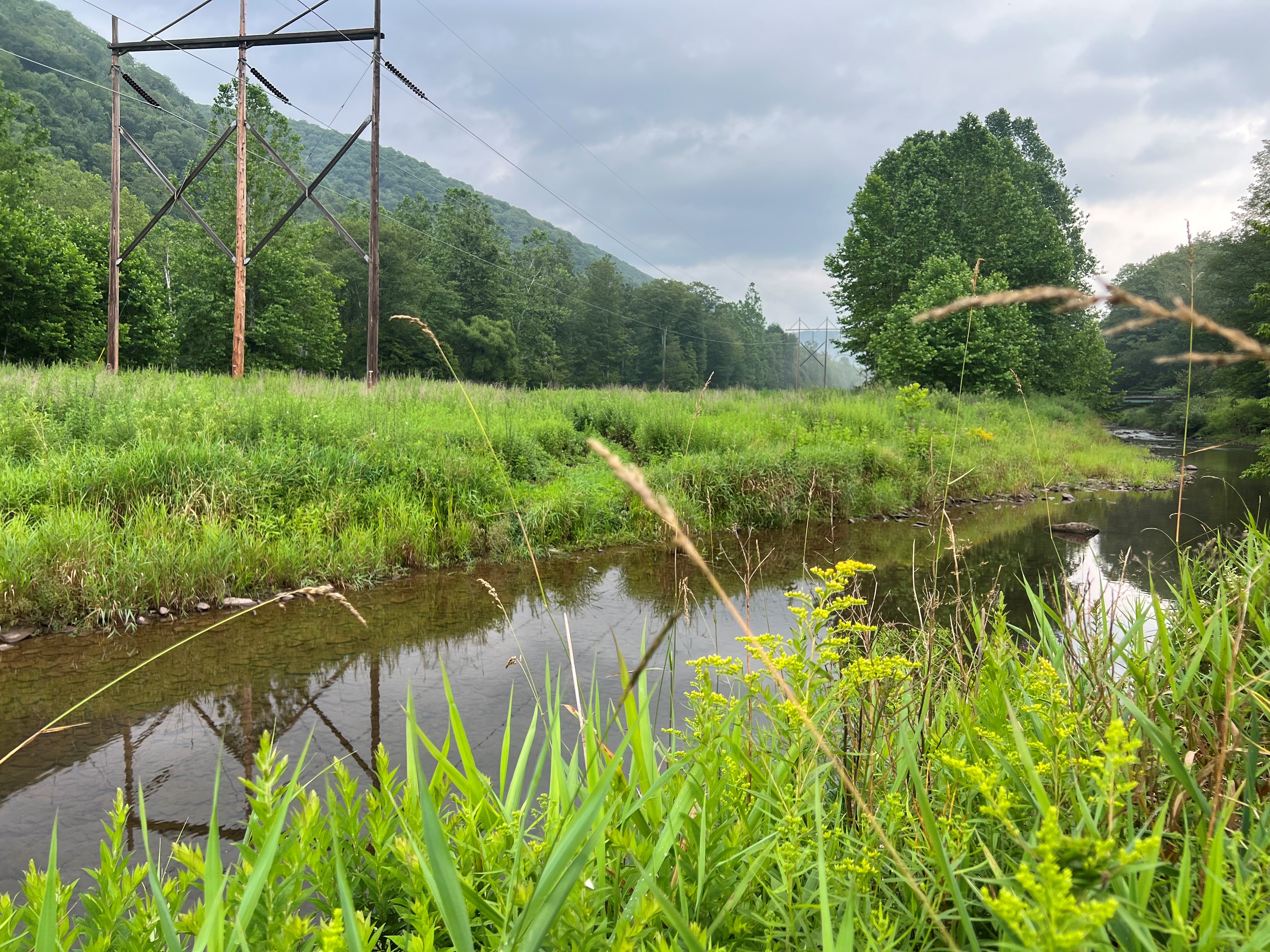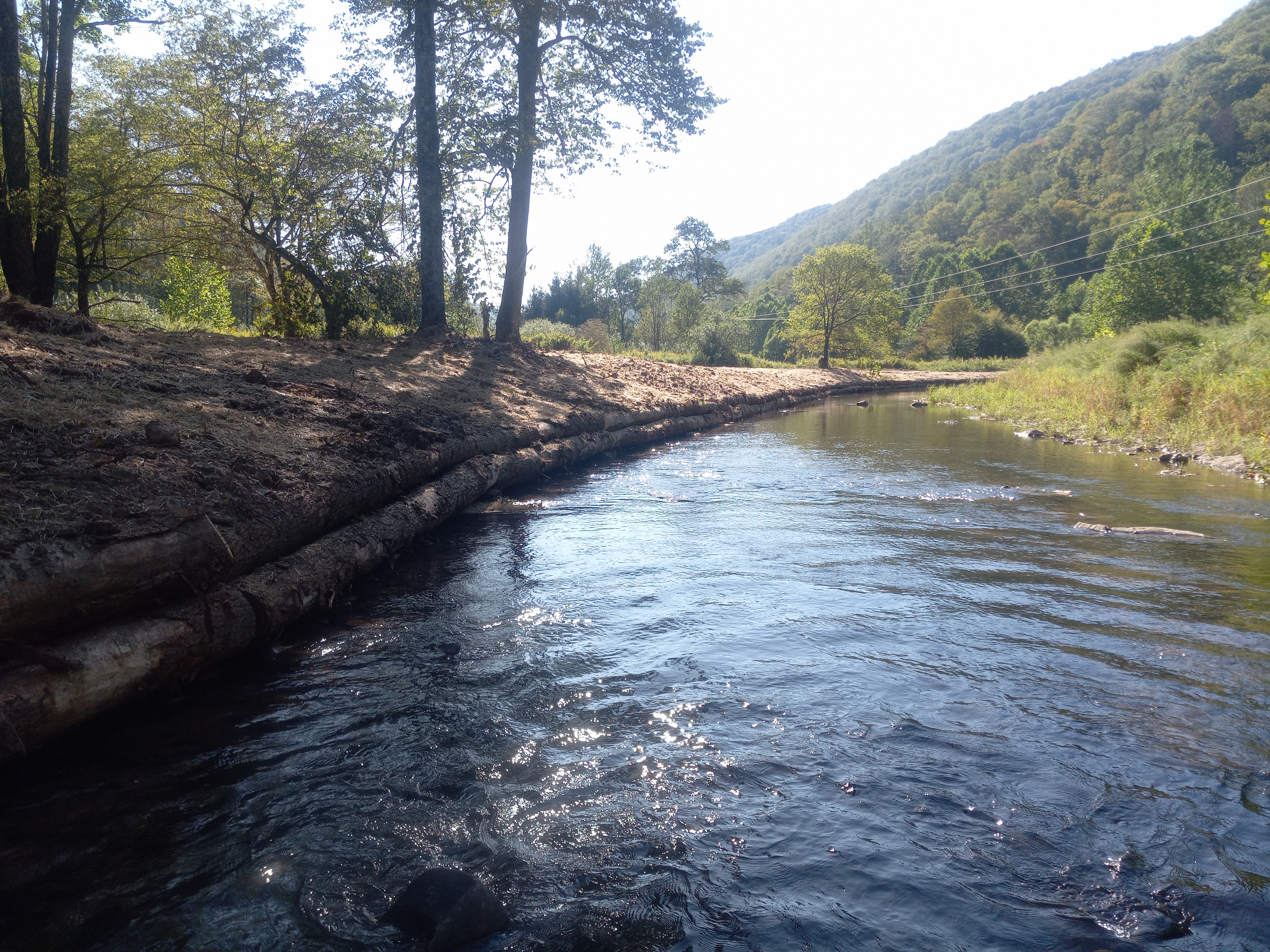|
Lycoming County Countywide Action Plan
“Providing county-based solutions and actions to reducing pollution by engaging local stakeholders to make a difference in water quality.”
Countywide Action Plan Information
Efforts are being made in Pennsylvania and its neighboring states to clean up our local waterways that run into the Chesapeake Bay. In 2019, the Pennsylvania Department of Environmental Protection submitted the Phase III Watershed Implementation Plan (WIP) that outline tangible nutrient reduction targets based on locally led efforts to reducewater pollution, enhance quality of life, deal with flooding issues, and receive credit for previously implemented best management practices. Contained with the Phase III WIP, was an innovative for all forty-three Pennsylvania Counties in the Chesapeake Bay watershed to draft a County Wide Action Plan.

Lycoming County drafted a Countywide Action Plan (CAP) in 2020 to serve as its framework for the county and its partners to achieve specific clean water goals. Lycoming County’s CAP contain initiatives aimed to accomplish the community objectives while also protecting Lycoming County’s natural resources for future generations. Before Lycoming County drafted their own CAP, each county received a “Technical Toolbox” from the Pennsylvania Department of Environmental Protection (PADEP) to help with CAP development. Lycoming County’s Toolbox was created to serve as a foundation for the county’s efforts to raise water quality in the area.
In February 2021, Lycoming County was ready to finalize its Countywide Action Plan by hosting a kickoff meeting to gain input from both PADEP and several local stakeholders. The final narrative of the Lycoming County Countywide Action Plan provides an overview of the goals and priory initiatives the county plans to make in order to reach pollution water goals by 2025. View the Lycoming County’s CAP Planning in action at October 19th Commissioner’s Public Meeting and the Kickoff Meeting.
The Countywide Action Plan is not regulatory, an unfunded mandate or a plan to increase taxes. While the WIP is technically voluntary, there are risks to not participating. Such risks could be additional regulations and government oversight, higher costs for compliance, EPA withholding or redirecting funding, missing
opportunities to access funding/technical assistance to address community needs.
Lycoming County Countywide Action Plan Updates:
3/21/24 - An informative presentation on the Countywide Action Plan was dicussed at recent Planning Commission meeting, focused on water quality initatives and grant funding opportunities. Leare more about the presentation here by viewing the powerpoint slides.
1/31/24 - We are exicted to announce the reintrouduction of the Countywide Action Plan Newsletter, aimed at providing a comprehensive overivew of our pogress, project highlights, valuable educaional resources and also announcments. The lastest edition is avaible now here.
1/24/24 - Our partnership meeting concluded successfully with lots of engaging dicussions. Powerpoint slides from the meeting are aviable to download here. We're excited to announce the 2024 CAP application grant round. Applications are due back to the CAP Coordinator on August 30th, 2024. Find more information about applying for CAP funds below.
1/8/23 - We are thrilled to announce our Upcoming Countywide Action Plan (CAP) Partnership Meeting on January 22nd at 2:00 PM! This gathering will be held at the Lycoming County 3rd Street Plaza, 6th Floor, Located at 33 West 3rd Street, Williamsport, Pa, 17701. Virtual attendance is available on Zoom with the sign-on link attached in the flyer/agenda.
The CAP Partnership Meeting aims to provide a brief, but informative presentation on the Countywide Action Plan program, funding availability and its process of implementing Best Management Pratices to meet the counties clean water goals by 2025. Download the flyer and agenda below to learn more!
Flyer | Agenda
12/1/23 - Lycoming County has been awarded Chesapeake Bay Community Clean Water Action Plan Coordinator and CAP Implementation Grant Funding to continue working towards our clean water goals in 2024. This significant grant will pave the way for stream restoration projects and help our cover crop incentive program with the Lycoming County Conservation District.
Read the official press release from the PADEP Newsroom here.
Why Countywide Action Planning Lycoming County?
 Lycoming County is just one of the forty-three Pennsylvania Counties to contain waterways that drain to either the Susquehanna or the Potomac rivers, which ultimately flow into the Chesapeake Bay. Lycoming County is just one of the forty-three Pennsylvania Counties to contain waterways that drain to either the Susquehanna or the Potomac rivers, which ultimately flow into the Chesapeake Bay.
As part of the Chesapeake Bay watershed, the county plays a significant role in contributing to the overall health of the bay. Lycoming County should prioritize efforts to reduce nutrient and sediment pollution following to bay due to the critical impact it has both local and regional ecosystems.
Excessive nutrients and sediment runoff from agricultural activities, urban areas and other sources lead to algal blooms, decreased oxygen levels, and impaired water quality in the bay. The pollution not only harms aquatic life but also affects fishing industries and recreational activities. Additionally, addressing these issues aligns with promoting sustainability and ensuring a healthier environment for future generations in Lycoming County and the Chesapeake Bay watershed as a whole.
Being the largest estuary in the United States, the Chesapeake Bay hold immense ecologicial significance. It vitually supports diverse ecosystems, acting as a critical habitat for numerous species of fish, birds, and other wildlife. Addititonally, it serves a essential waterway that contributes to water quality acting as a natural filter that improves the health of the surrounding lands and communities.
(Map of Lycoming County in the Chesapeake Bay Watershed)
Clean Water Goals for Lycoming County
Lycoming County needs to remove 1.255 M pounds of nitrogen and 76 K pounds of phosphorus from it’s current nutrient pollution. Since 1985, Lycoming County has made strives in the terms of lowering the amount of phosphorus from entering nearby rivers, however, significant reductions are still required to reach the 2025 target. In regards to nitrogen, a lot of effort stills needs to be done. The county’s aim is to totally eliminate the reductions required by 2025 for both phosphorus and nitrogen through the Countywide Action Plan planning process. State and municipal initiatives might be needed to complete this goal. The clean water goal for Lycoming County is further summarized below:
 |
The monitored nitrogen and phosphorus load for Lycoming County (above) are broken down into nitrogen and phosphorus goals. The top line represents the conditions of Lycoming County in 1985. The second line, 2019, represents the current conditions in Lycoming County. The second line, 2019, represents the current conditions in Lycoming County. The third line represents the planning goal that Lycoming Cunty is trying to achieve by 2025. The last line represents the total reduction in pounds that Lycoming County needs to reduce by 2025.
Current conditions of the waterways in Lycoming County show that the county has elevated amounts of nitrogen, phosphorus, and sediment. However, the water quality of Lycoming County is currently changing over time:
-
Of the 2,247 miles of streams in Lycoming County, approximately 8% are degraded, which means they do not meet water standards.
-
Groundwater samples were taken throughout Lycoming County. A small number of measured groundwater nitrate levels that exceed the EPA's safe drinking threshold of 10 mg/L.
-
Lycoming County has many listed as impaired, by only a few streams within the county have individual TMDL's.
* TMDL (Total Maximum Daily Loads): Determines the maximum quantity of a pollutant that can enter a body of water in order for the body of water to meet and remain compliant with water quality requirements for that specific pollutant. A TMDL establishes a target for reducing pollutants and assigns the load reductions required to the pollutant source.
Current Stream Conditions of Lycoming County
Eligibility for Countywide Action Plan funding typically extends too various entities such as non-profit 501(c) organizations, local governments/local government agencies, municipal governments, educational institutions, local businesses (headquarters must be located in Lycoming County) and unincorporated individuals. Other organizations such as state agencies, federal agencies, and etc. are ineligible for CAP Funding.
Countywide Action Plan Funding supports the implementation of a broad spectrum of projects. However, Lycoming County CAP’s seeks an adaptive approach to improve local water quality that consist of best management practices (BMPs) that treat stormwater runoff from either agricultural or urban sectors and/or restore unstable stream systems. Moreover, projects must demonstrate the ability to reduce phosphorous, nitrogen and sediment pollution in our waterways. As this is reflected to the overall of the Lycoming County Countywide Action Plan. Projects should also showcase readiness for immediate implementation and be considered “shovel-ready” to ensure they are poised for swift commencement upon funding allocation.
Learn more about the CAP funding eligibility by reviewing the Lycoming County CAP Subaward Guidelines and Application listed under Lycoming County CAP documents for applicants.
Lycoming CAP Documents for Applicants
Triumphs for Clean Water in Lycoming County
 |
 |
The completion of five stream restoration and fish habitat projects, coupled with the implementation of a cover crop incentive program (the Lycoming County Conservation District) totaling nearly $500,000.000 of CAP dollars marks a significant triumph in Lycoming County’s pursuit of clean water goals. These endeavors showcase a dedicated community to environmental stewardship, aiming to improve water quality and restore aquatic habitats. The stream restoration initiatives not only enhance the health of waterways but also foster improved habitats for fish and other aquatic life. Moreover, the cover crop incentive program that is partnered with the Lycoming County Conservation District demonstrates a proactive approach in mitigating nutrient runoff from agricultural lands, safeguarding the regions water resources. These collective efforts stand as commendable milestones in preserving ecological balance of Lycoming County’s streams while contributing positively to the Chesapeake Bay watershed.
You can learn more about Lycoming County’s CAP Project by tracking them on our StoryMap. Lycoming County’s impactful CAP work was recently highlighted in the latest issue of the PADEP Healthy Waters Newsletter.
Lycoming County CAP Newsletters
Stay informed with our CAP newsletter. Explore the latest updates on the CAP, discover project highlights, delve into enriching enivronmental education content, and be the first to know abut important announcements.
Want to learn more about Lycoming County's CAP?
Contact the Lycoming County Countywide Action Plan Coordinator at the information below to learn more!
Nikki, GIS Analyst/Environmental Planner / CAP Coordinator
Lycoming County Planning & Community Development
48 West Third Street, Williamsport, PA 17701
Phone: (570) 329-4761 | Email: nmcarter@lyco.org
|
|
|
|
|